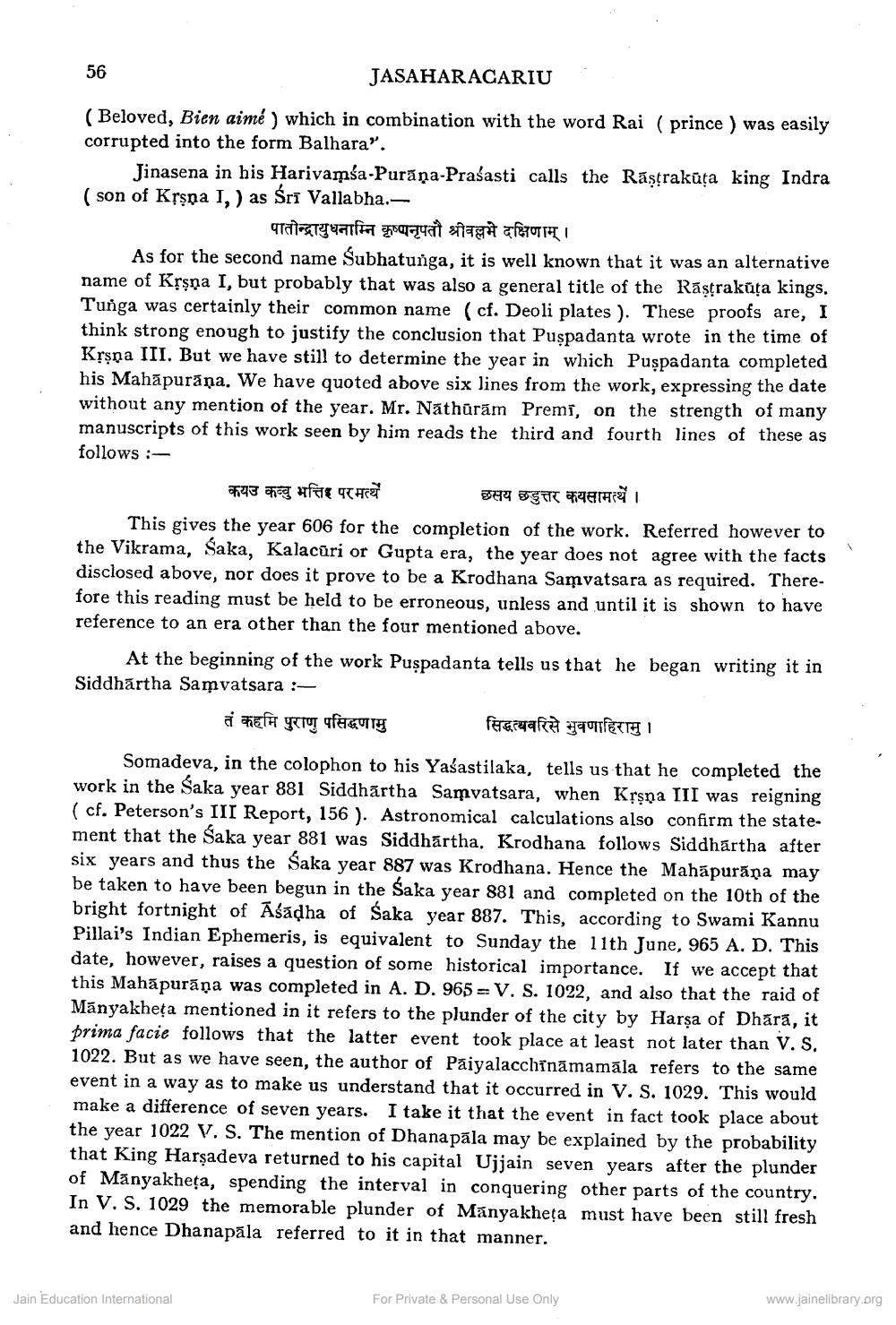________________
56
JASAHARACARIU
(Beloved, Bien aimé ) which in combination with the word Rai (prince ) was easily corrupted into the form Balhara".
Jinasena in his Harivamsa-Purā ņa-Prasasti calls the Răstrakūta king Indra ( son of Krşpa I,) as Śrī Vallabha.
पातीन्द्रायुधनाम्नि कृष्णनृपतौ श्रीवल्लभे दक्षिणाम् । As for the second name Subhatunga, it is well known that it was an alternative name of Krşņa I, but probably that was also a general title of the Răstrakūta kings. Tunga was certainly their common name (cf. Deoli plates). These proofs are, I think strong enough to justify the conclusion that Puşpadanta wrote in the time of Krşpa III. But we have still to determine the year in which Puşpadanta completed his Mahāpurāņa. We have quoted above six lines from the work, expressing the date without any mention of the year. Mr. Nathūrām Premi, on the strength of many manuscripts of this work seen by him reads the third and fourth lines of these as follows: कयउ कव्वु भत्तिह परमत्थे
छसय छडुत्तर कयसामत्थे । This gives the year 606 for the completion of the work. Referred however to the Vikrama, Saka, Kalacūri or Gupta era, the year does not agree with the facts disclosed above, nor does it prove to be a Krodhana Samvatsara as required. Therefore this reading must be held to be erroneous, unless and until it is shown to have reference to an era other than the four mentioned above.
At the beginning of the work Puşpadanta tells us that he began writing it in Siddhartha Samvatsara :
तं कहमि पुराणु पसिद्धणामु
सिद्धत्यवरिसे भुवणाहिरामु ।
Somadeva, in the colophon to his Yaśastilaka, tells us that he completed the work in the Saka year 881 Siddhārtha Samvatsara, when Krşņa III was reigning (cf. Peterson's III Report, 156 ). Astronomical calculations also confirm the statement that the Saka year 881 was Siddhartha. Krodhana follows Siddhartha after six years and thus the Saka year 887 was Krodhana. Hence the Mahāpurāņa may be taken to have been begun in the Saka year 881 and completed on the 10th of the bright fortnight of Āsādha of Saka year 887. This, according to Swami Kannu Pillai's Indian Ephemeris, is equivalent to Sunday the 11th June, 965 A. D. This date, however, raises a question of some historical importance. If we accept that this Mahāpurāņa was completed in A. D. 965 = V. S. 1022, and also that the raid of Mānyakheța mentioned in it refers to the plunder of the city by Harsa of Dhārā, it prima facie follows that the latter event took place at least not later than V.S. 1022. But as we have seen, the author of Paiyalacchināmamāla refers to the same event in a way as to make us understand that it occurred in V. S. 1029. This would make a difference of seven years. I take it that the event in fact took place about the year 1022 V. S. The mention of Dhana pāla may be explained by the probability that King Harșadeva returned to his capital Ujjain seven years after the plunder of Manyakheța, spending the interval in conquering other parts of the country. In V. S. 1029 the memorable plunder of Mányakheta must have been still fresh and hence Dhanapāla referred to it in that manner.
For Private & Personal Use Only
Jain Education International
www.jainelibrary.org




